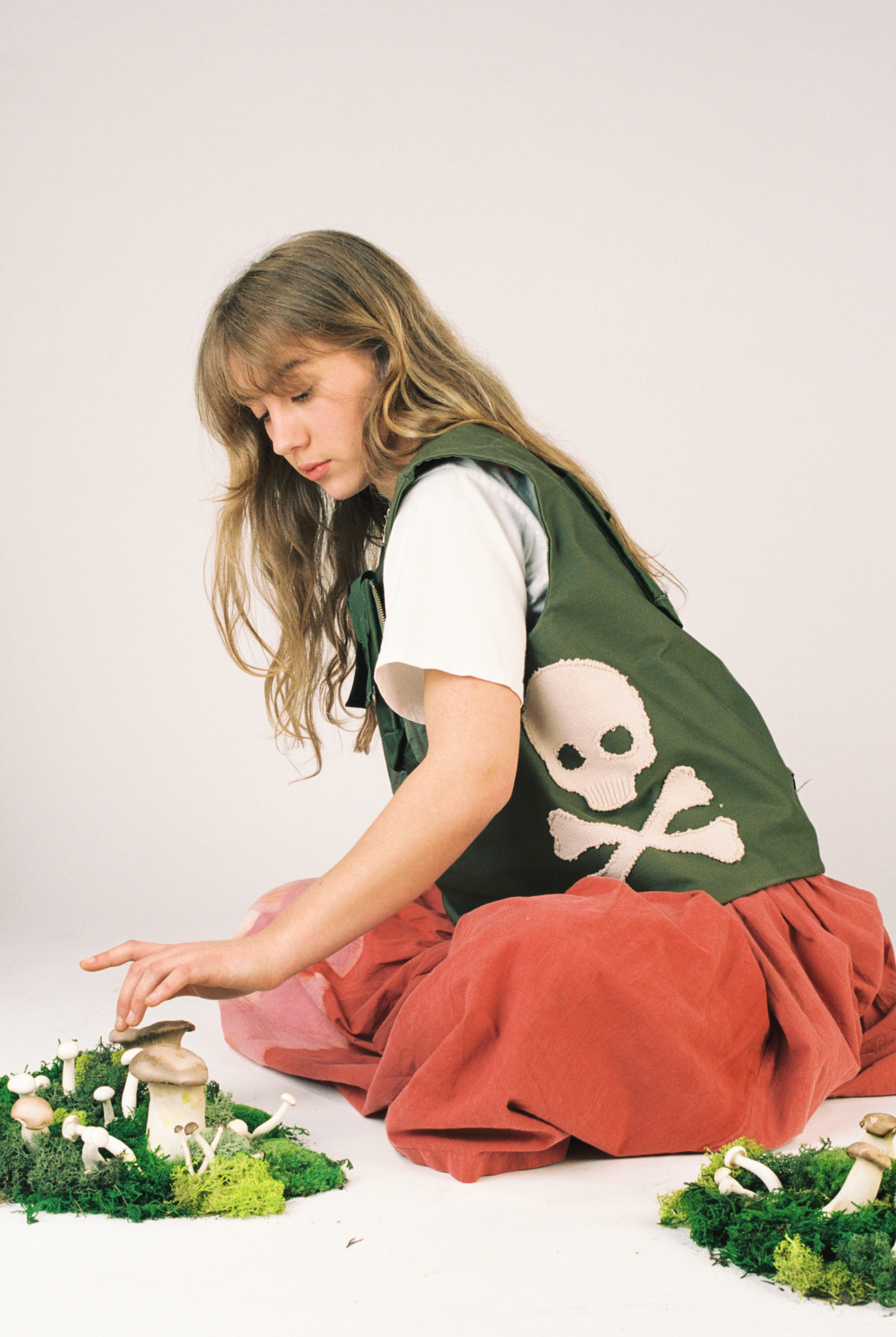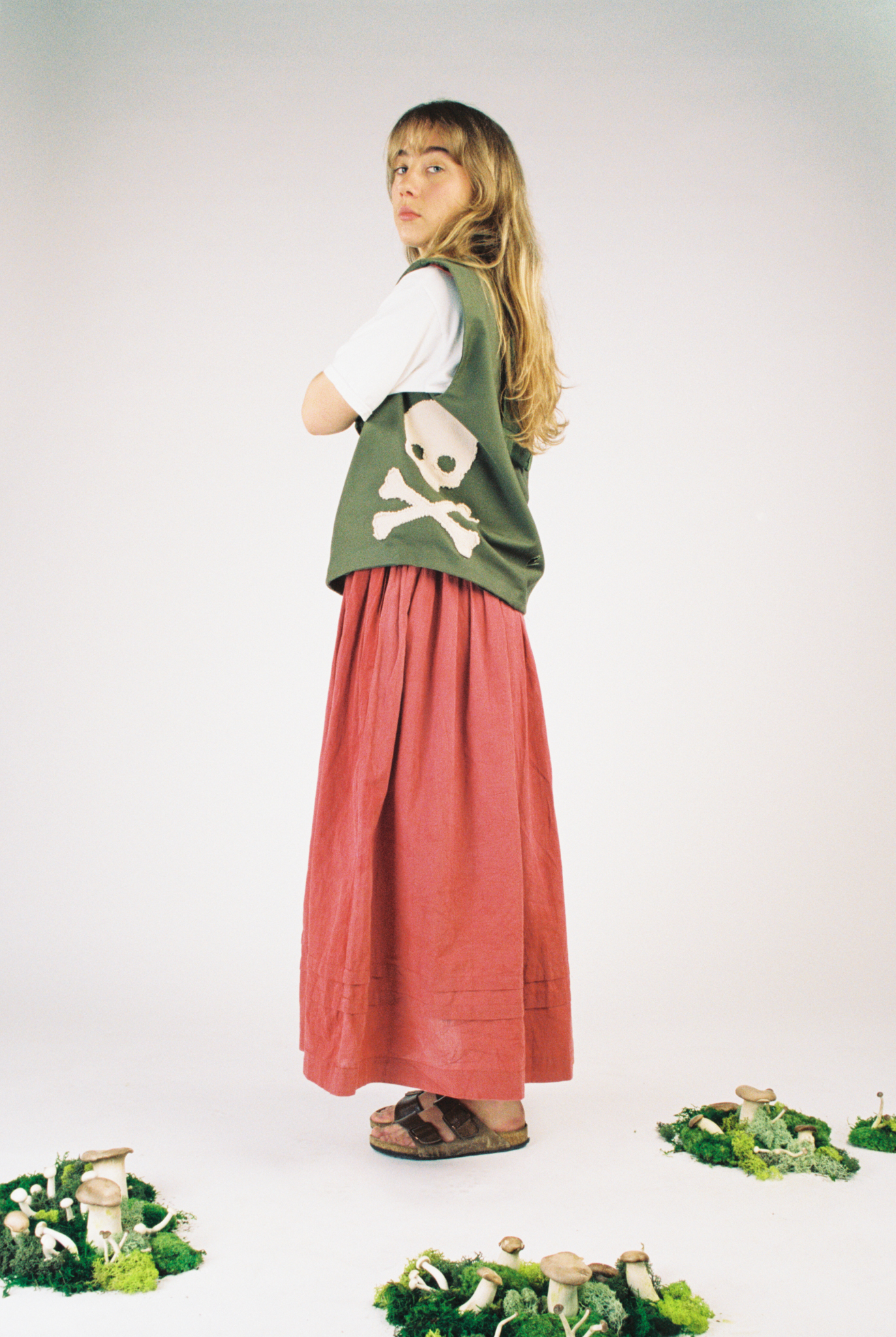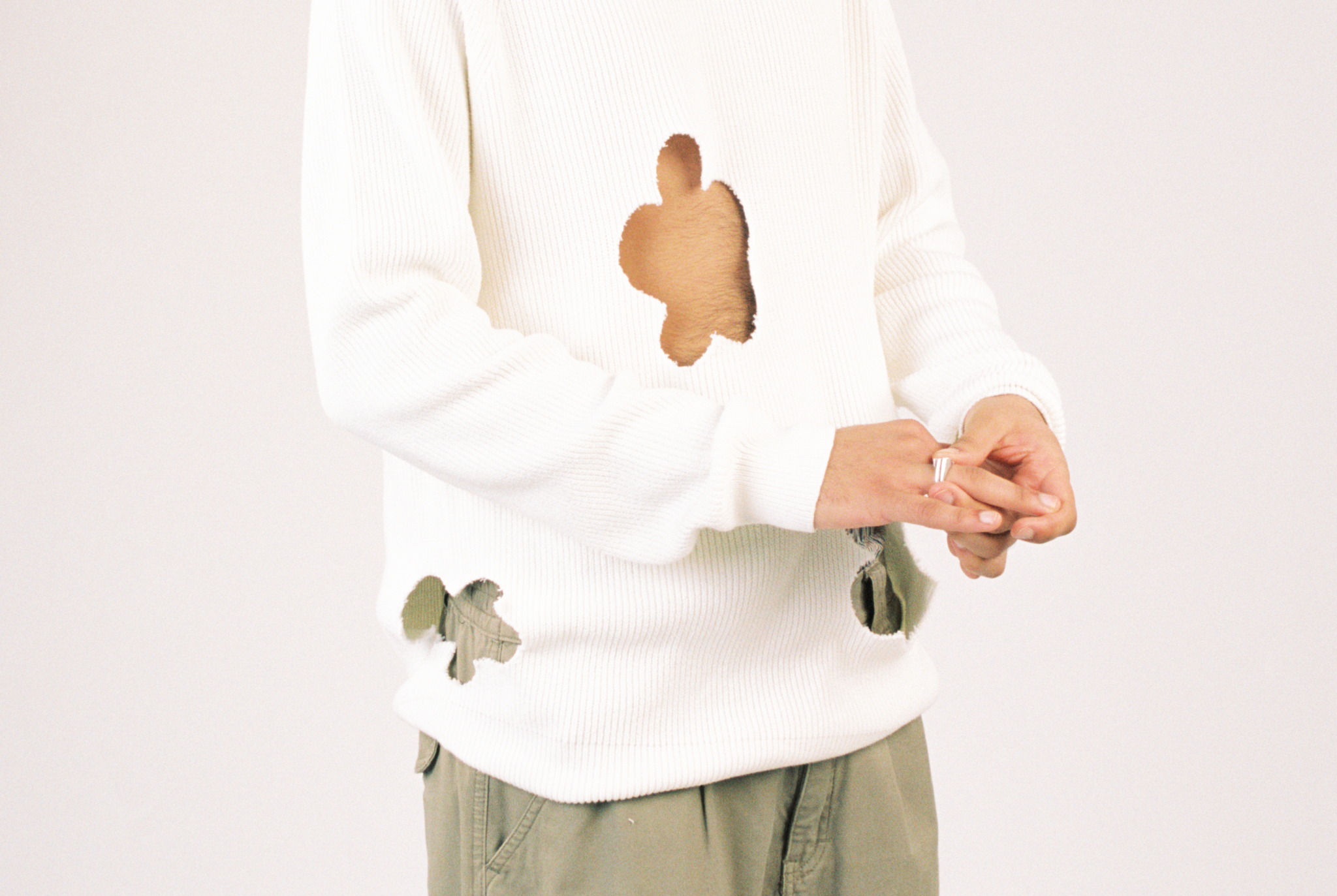Photography Lara Coassin
Models Phoebe Balinska and Talyn Sandhu
Styling Joshua Samuels ~ Latest Collection
Shoot Assistants Jasmine Gillanders, Jessie Johnson, Phoebe Balinska, Silvia Anzoletti
Words Lara Coassin
Joshua Samuels has recently graduated from the University of Brighton with a degree in Fashion Design with Business Studies. With growing concerns around the fashion industry, Samuels started his eponymous brand and has since created upcycled clothing to bring new life to old garments. We spoke about the early beginnings of his brand, sourcing fabrics, and his concept of sustainable fast fashion.


Joshua Samuels End of second year, Covid had just hit, I had moved back home, and I was really bored like everyone else. And uhm, do you know who Sam Nowell is?
He was upcycling but in a really simple way. And it was things like getting a Burberry trench coat and finding a towel from a charity shop and doing cool stuff with it.
And then I started doing some research, and that’s just not out there, there isn’t an affordable option [for upcycled clothes]. And I thought I could do that. So I did. I started buying stuff from charity shops and ordering things off eBay and other vintage websites and just started playing with things. And then when I had a decent amount of stuff, I decided to make a look book which I probably wasn’t allowed to do because it was lockdown.
I made a website, posted them, people bought the things, and then I did it again. ︎︎︎

JS Yeah, it was interesting, because the way we were approaching upcycling when I was at Liam [Hodges] was so different from how I was doing it at mine.
LC How come?
JS There, we were taking old clothes and creating new silhouettes. For my brand, other than a few jumpers and a couple of trousers, it’s literally just appliqué. That’s how I’m keeping costs so low, if you reduce process enough it’s cost-effective. Because it means at Liam [Hodges] I’d be spending hours and hours making something, with the brand, it’s a cheap way to make clothes. I’m getting an old jumper that is nice and I’m cutting up another old jumper and making it nicer.
And with pieces like the flower jeans, it’s about finding things that are really easily scalable like a Levi’s 501. There are a million sitting in dumps everywhere, everyone likes blue jeans. There we go [points at my blue jeans]. ︎︎︎

LC Do you think you learned a lot that would help you now with your degree or your own brand?
JS You know what, I probably learned more [interning] than I did first and second year of uni. Actually, being in a brand and seeing how it operates is… I mean it was a small brand, so you got to do like a bit of everything. And you learn things that you don’t get to learn on a course.
JS The thing is in fashion I think it’s more about personality than it is about skills when you’re starting off. I just think you have to be able to get along with the people. ︎︎︎

JS I don’t think I’ve learned many tips and tricks; I think I just make stuff I like.
Find a niche. Oh, my only tip I guess is “Don’t be boring.”. So yeah, just try and do something a little bit different, I guess.
Make a website, and post stuff on Instagram.
LC I was about to say, you used your personal [Instagram account] to turn into your brand?
JS I deleted everything off the Instagram I already had, which helped because it meant I already had some mates following me. Just post stuff. I don’t know I’m bad I haven’t posted anything in months. The brand’s come to a stop, uni has taken over. I had to turn down so many opportunities I’m upset about but opportunities will come back around. Every opportunity that has come to me has been through Instagram. And it’s free! Imagine, you were trying to start a brand 20 years ago. You’d have to pay for magazine space, billboards, or word of mouth. ︎︎︎

JS Well, it’s about finding what you want to find and then grabbing what you can. Specific things, that are upscalable, so, for example, those [flower] jumpers, looking for college spell out hoodies and there’s a million of them out there; someone leaves uni and never wears this anymore.
LC How do you find the other jumpers to go on them? Charity shops? eBay?
JS Yeah, charity shops, eBay, there’s a bunch of websites, vintage places. With the flowers and the skulls, it’s just cream knitwear.
Sourcing takes longer than making but it will get easier as I meet more people and more avenues.
LC Do you have any contacts you work with regularly?
JS I know a really good person, what’s his name... Jarrod, who works at this vintage warehouse. And they sort through 3.2 million tonnes of waste every year, which is absurd. Actually, it might be every day. It’s, it’s a London tube full of clothes every day!
LC Where do all those clothes go?
JS Either to people like me or they sell it off abroad.
LC So, people like you grab and then make sure that it doesn’t go to landfill?
JS Yeah, and more people like that would make it easier. Instead of me going to a charity shop and then another charity shop, and then another charity shop, looking for jeans, they’ve got a box full of jeans, and I can choose. ︎︎︎


JS Personally? Enough.
What do you think fast fashion is? The problem with fast fashion comes down to it being so cheap because they’re unethically making it, and because they’re using lots of cheap polymers in their textiles. It’s the throwaway nature of it that makes it bad.
I care about sustainability, but I can’t afford the difference between a £60 pair of jeans or a £600 pair of jeans. I care but me and everyone else I know don’t care enough to spend £540 extra. You know if I was making enough money, I’d care that much but I can’t afford to spend a month’s rent on a pair of jeans. There’s not an option out there, if you look for an upcycling company where you can buy a pair of jeans for £60, £50, you can’t find it.
Slow fashion is a great movement but we can’t afford it. And if 98% of people want fast fashion, give them an option to be able to do it sustainably. Because that’s the only way the industry is going to change because consumers aren’t going to change. But if you want to make a big difference, you need to be able to make affordable fashion on a big scale that is sustainable. It needs to be accessible and that’s what I want to do, I want to make a fast fashion company that is sustainable. You can keep catering to the 2% and that’s great, but if you couldn’t sell to the other 98% that doesn’t necessarily even care about [sustainability]. Like it would be great if everyone woke up tomorrow and decided it was time to act sustainably but it’s not going to happen. I don’t care if the person that buys something doesn’t actually care about the environment, they’re buying something that is good for the environment. It doesn’t matter why they’re doing it ... I guess, I’m trying to trick consumers.
LC Do you think people will hold on to the garments? Do you care about their longevity?
JS I hope so, and they’re made in a way that means that they will last, and I hope that people would keep on to it. It’s about finding a better option. I’d rather someone bought something from me and had it for two months than they’d bought something from Asos and had it for two months. Because the stuff that I’m getting might be from Asos that would have otherwise been waste and now it’s not. ︎︎︎

JS I was reading about Eastern teachings and this guy started speaking about this process of being born, living, and dying; it’s a simple way to look at it but he described it as the process of living, dying, being absorbed into the ground, where then little animals feed off you, microorganisms feed off you, and then you go into the soil, and then you fertilise the soil, and you become new [life]. And I thought that was really beautiful and a really good metaphor for upcycling. It’s these old jumpers and jeans and whatnot that someone decided they didn’t want, and then I got it and I cut it up like a little microorganism and turned it into a tree. ︎︎︎

JS It was about finding the cheesiest and easiest motive that symbolises [death and rebirth]. The first thing that you think of when you look at a skull is death and the first thing you think of when you look at a flower is life. Besides flowers are a specifically good shape because they almost fit as a tile. So, it means that when I’m cutting up a jumper, I can fit lots of them and there’s barely any waste to it. The skulls are a little bit more annoying, in that I want to follow the grainline. It depends on the size of the jumper, but you can still get about six or seven out of each [jumper] that would have otherwise just gone to waste.
LC Do you think you’ll change up your design over time? Or do you think you’ll keep those symbolic core elements?
JS Yeah, I’ll keep it but there will be new stuff. You don’t want to stay stagnant. Like a normal logo, there will be iterations.
LC [At the shoot] a lot of people asked about the navy flower jumper...
JS Summer, I’m going to make loads of those the moment I graduate.
Keep an eye out for his flower jumpers and shop his latest collection here.
~ (Brighton and Hove, April 2022)

